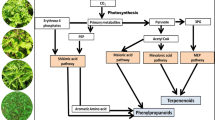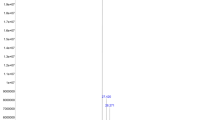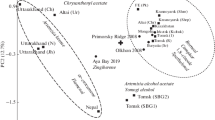Abstract
The leaf essential oils from five species of Zanthoxylum (Rutaceae) from Monteverde, Costa Rica, have been obtained by hydrodistillation and analyzed by gas chromatography-mass spectrometry. The species examined include Z. fagara, Z. acuminatum, Z. melanostictum, Z. monophyllum, and an undescribed species. The most abundant classes of compounds found in Zanthoxylum leaf oils are acyclic and menthane monoterpenoids as well as simple alcohols, aldehydes, and ketones. In terms of molecular diversity, menthane and acyclic monoterpenoids, cadinane and mesocyclic sesquiterpenoids, and simple alcohols, aldehydes, and ketones dominate the essential oils of Zanthoxylum species. Monoterpenoids make up the majority of the mass of the leaf oils of Z. monophyllum, Z. acuminatum, Z. fagara, and Zanthoxylum sp. nov. Linalool, 4-terpineol, α-terpineol, and trans-2-hexenol, are found in all of the Zanthoxylum species examined in this study.
Similar content being viewed by others
Abbreviations
- asl:
-
above sea level
- dbh:
-
diameter at breast height
- GC:
-
gas chromatograph/chromatography
- MS:
-
mass spectrum/spectrometer
- MSD:
-
mass selective detector
- NIST:
-
National Institute of Science and Technology
- psi:
-
pounds per square inch
- RI:
-
retention index
- sp. nov.:
-
new species.
References
Clark, K.L., Lawton, R.O. and Butler, P.R., The physical environment, In Nadkarni, N.M. and Wheelwright, N.T. (Eds.), Monteverde: Ecology and Conservation of a Tropical Cloud Forest, Oxford University Press, New York (2000) pp. 15–38.
Haber, W.A., Plants and vegetation, in Nadkarni, N.M. and Wheelwright, N.T. (Eds.), Monteverde: Ecology and Conservation of a Tropical Cloud Forest, Oxford University Press, New York (2000) pp. 39–94.
Schultes, R.E. and Raffauf, R.F., The Healing Forest. Medicinal and Toxic Plants of the Northwest Amazonia, Dioscorides Press, Portland, Oregon, 1990.
Gentry, A.H., A Field Guide to the Families and Genera of Woody Plants of Northwest South America, University of Chicago Press, Chicago, Illinois, 1993.
Shiva, M.P., Lehri, A. and Shiva, A., Aromatic & Medicinal Plants: Yielding Essential Oil for Pharmaceutical, Perfumery, Cosmetic Industries and Trade, International Book Distributors, Dehradun, India, 2002.
Kalyani, G.A., Aithal, K.S. and Srivastava, K.K., In vitro anthelmintic activity of essential oil from the fruits of Zanthoxylum limonella, Fitoterapia, 60 (1989) 160–162.
Itthipanichpong, C., Ruangrungsi, N. and Pattanaautsahakit, C., Chemical compositions and pharmacological effects of essential oil from the fruit of Zanthoxylum limonella, J. Med. Assoc. Thai., 85(suppl 1) (2002) S344–S354.
Hutchings, A., Scott, A.H., Lewis, G. and Cunningham, A., Zulu Medicinal Plants: An Inventory, University of Natal Press, Pietermaritzburg, 1996.
McGaw, L.J., Jager, A.K. and van Staden, J., Antibacterial, anthelmintic and anti-amoebic activity in South African medicinal plants, J. Ethnopharmacol., 72 (2000) 247–263.
Setzer, W.N., Schmidt, J.M., Eiter, L.C. and Haber, W.A., The leaf oil composition of Zanthoxylum fagara (L.) Sarg. from Monteverde, Costa Rica, and its biological activities, J. Essent. Oil Res., 16 (in press).
Adams, R.P., Identification of Essential Oil Components by Gas Chromatography/Mass Spectrometry, Allured Publishing, Carol Stream, Illinois, 2001.
Epstein, W.W. and Gaudioso, L.A., Volatile oil constituents of sagebrush, Phytochemistry, 23 (1984) 2257–2262.
Lota, M.-L., de Rocca Serra, D., Tomi, F. and Casanova, J., Chemical variability of peel and leaf essential oils of mandarins from Citrus reticulata Blanco, Biochem. System. Ecol., 28 (2000) 61–78.
Lota, M.-L., de Rocca Serra, D., Tomi, F. and Casanova, J., Chemical variability of peel and leaf essential oils of 15 species of mandarins, Biochem. System. Ecol., 29 (2001) 77–104.
Ehret, C. and Maupetit, P., Two sinapyl alcohol derivatives from bergamot essential oil, Phytochemistry, 21 (1980) 2985.
Gancel, A.L., Ollitrault, P., Froelicher, Y., Tomi, F., Jacquemond, C., Luro, F. and Brillouet, J.M., Leaf volatile compounds of seven citrus somatic tetraploid hybrids sharing willow leaf mandarin (Citrus deliciosa Ten.) as their common parent, J. Agric. Food Chem., 51 (2003) 6006–6013.
Tirado, C.B., Stashenko, E.E., Combariza, M.Y. and Martinez, J.R., Comparative study of Colombian citrus oils by high-resolution gas chromatography and gas chromatography-mass spectrometry, J. Chromatogr. A, 697 (1995) 501–513.
Kaneko, N., Hasegawa, S., Hirose, Y., 1985. Terpenoids from seeds of Abies firma, Phytochemistry, 24 (1985) 185–186.
Li, H. and Madden, J.L., Analysis of leaf oils from a Eucalyptus species trial, Biochem. System. Ecol., 23 (1995) 167–177.
Setzer, W.N., Setzer, M.C., Moriarity, D.M., Bates, R.B., and Haber, W.A., Biological activity of the essential oil of Myrcianthes sp. nov. “black fruit” from Monteverde, Costa Rica, Planta Med., 65 (1999) 468–469.
Homer, L.E., Leach, D.N., Lea, D., Slade Lee, L., Henry, R.J. and Baverstock, P.R., Natural variation in the essential oil content of Melaleuca alternifolia Cheel (Myrtaceae), Biochem. System. Ecol., 28 (2000) 367–382.
De Feo, V., De Simone, F. and Senatore, F., Potential allelochemicals from the essential oil of Ruta graveolens, Phytochemistry, 61 (2002) 573–578.
Hognadottir, A. and Rouseff, R.L., Identification of aroma active compounds in orange essence oil using gas chromatography–olfactometry and gas chromatography–mass spectrometry, J. Chromatogr. A, 998 (2003) 201–211.
Tava, A. and Pecetti, L., Volatiles from Medicago sativa complex flowers, Phytochemistry, 45 (1997) 1145–1148.
Avato, P. and Tava, A., Acetylenes and terpenoids of Bellis perennis, Phytochemistry, 40 (1995) 141–147.
Ngassoum, M.B., Essia-Ngang, J.J., Tatsadjieu, L.N., Jirovetz, L., Buchbauer, G. and Adjoudji, O., Antimicrobial study of essential oils of Ocimum gratissimum leaves and Zanthoxylum xanthoxyloides fruits from Cameroon, Fitoterapia, 74 (2003) 284–287.
Stashenko, E.E., Acosta, R. and Martnez, J.R., High-resolution gas-chromatographic analysis of the secondary metabolites obtained by subcritical-fluid extraction from Colombian rue (Ruta graveolens L.), J. Biochem. Biophys. Meth., 43 (2000) 379–390.
Chakraborty, D.P., Barman, B.K. and Bose, P.K., On the constitution of murrayanine, a carbazole derivative isolated from Murraya koenigii Spreng, Tetrahedron, 21 (1965) 681–685.
Author information
Authors and Affiliations
Corresponding author
Rights and permissions
About this article
Cite this article
Setzer, W.N., Noletto, J.A., Lawton, R.O. et al. Leaf essential oil composition of five Zanthoxylum species from Monteverde, Costa Rica. Mol Divers 9, 3–13 (2005). https://doi.org/10.1007/s11030-005-1298-6
Received:
Accepted:
Issue Date:
DOI: https://doi.org/10.1007/s11030-005-1298-6




